Logistics and Supply Chain Management
Added on 2023-01-23
21 Pages4395 Words28 Views
Running Head: LOGISTICS AND SUPPLY CHAIN MANAGEMENT
Logistics and Supply chain management
Student’s Name
University Name
Author’s Note
Logistics and Supply chain management
Student’s Name
University Name
Author’s Note
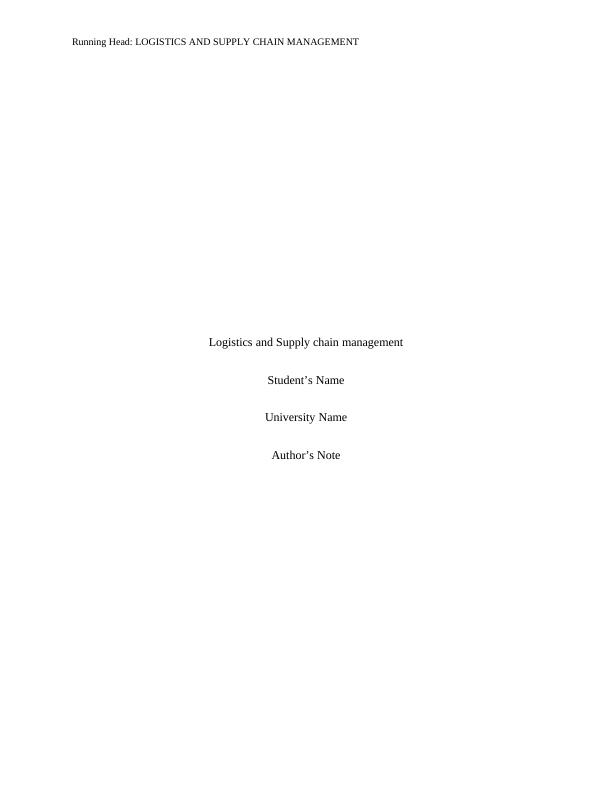
2
LOGISTICS AND SUPPLY CHAIN MANAGEMENT
Table of Contents
1. Overview of the Organization..................................................................................................3
1.1 Mission Statement..............................................................................................................3
2. Discussion....................................................................................................................................4
2.1 SCOR Model of Supply Chain Management for Nestle Waters...........................................4
2.1.1 Planning phase of supply chain management.....................................................................4
2.1.2 Sourcing...........................................................................................................................5
2.1.2.1 Downstream and Upstream Activities..........................................................................5
2.1.2.2 Operations............................................................................................................................6
2.1.3 Making................................................................................................................................7
2.1.4 Delivery...............................................................................................................................8
3. Sustainability and Green Logistics Risks....................................................................................8
3.1 Water Risks............................................................................................................................9
3.2 Nexus of energy, water, food as well as climate....................................................................9
3.3 The New Economics of Water.............................................................................................10
3.4 Risk Assessment..................................................................................................................12
4. Outlining the key actions for addressing the risks.....................................................................16
4.1 Starting at Home..................................................................................................................16
4.2 Understanding the Water Risks............................................................................................16
LOGISTICS AND SUPPLY CHAIN MANAGEMENT
Table of Contents
1. Overview of the Organization..................................................................................................3
1.1 Mission Statement..............................................................................................................3
2. Discussion....................................................................................................................................4
2.1 SCOR Model of Supply Chain Management for Nestle Waters...........................................4
2.1.1 Planning phase of supply chain management.....................................................................4
2.1.2 Sourcing...........................................................................................................................5
2.1.2.1 Downstream and Upstream Activities..........................................................................5
2.1.2.2 Operations............................................................................................................................6
2.1.3 Making................................................................................................................................7
2.1.4 Delivery...............................................................................................................................8
3. Sustainability and Green Logistics Risks....................................................................................8
3.1 Water Risks............................................................................................................................9
3.2 Nexus of energy, water, food as well as climate....................................................................9
3.3 The New Economics of Water.............................................................................................10
3.4 Risk Assessment..................................................................................................................12
4. Outlining the key actions for addressing the risks.....................................................................16
4.1 Starting at Home..................................................................................................................16
4.2 Understanding the Water Risks............................................................................................16
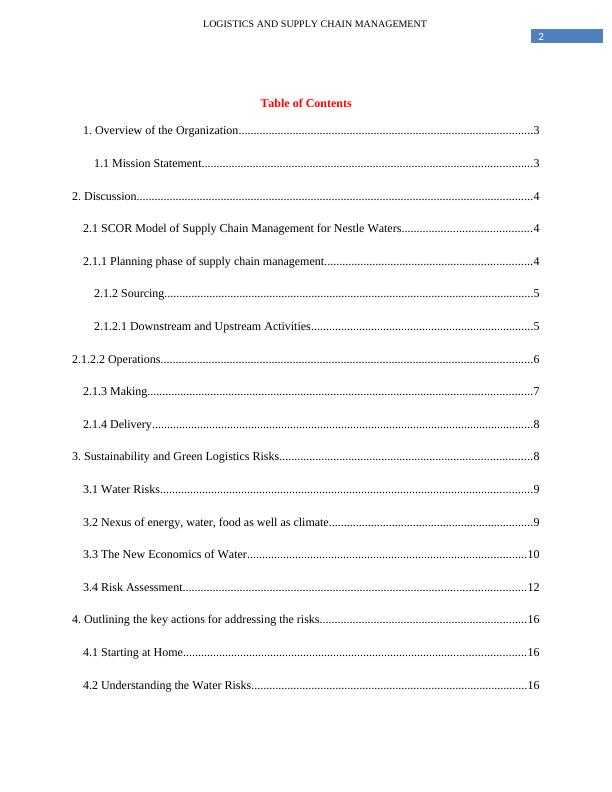
3
LOGISTICS AND SUPPLY CHAIN MANAGEMENT
4.3 Development and evolution of the Strategic Management plan of Nestle Waters..............17
4.4 Engagement of the associates..............................................................................................17
Reference List................................................................................................................................18
LOGISTICS AND SUPPLY CHAIN MANAGEMENT
4.3 Development and evolution of the Strategic Management plan of Nestle Waters..............17
4.4 Engagement of the associates..............................................................................................17
Reference List................................................................................................................................18
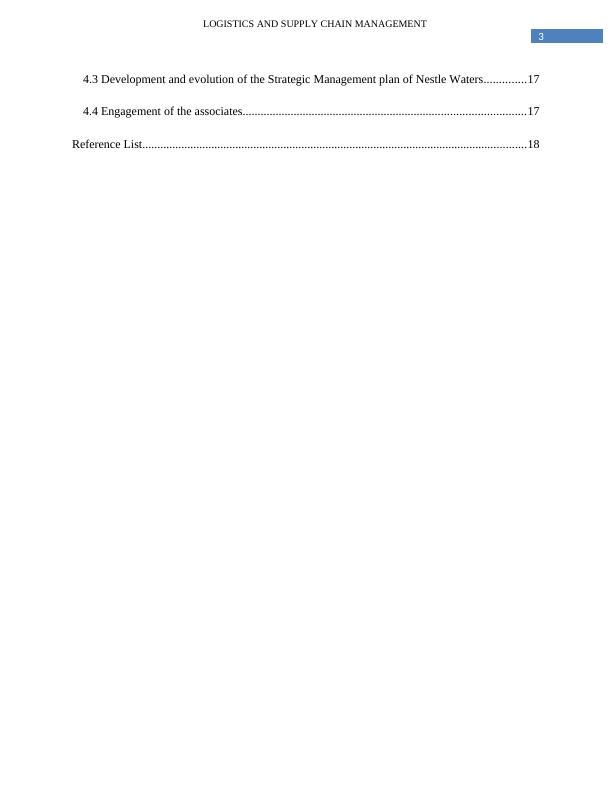
4
LOGISTICS AND SUPPLY CHAIN MANAGEMENT
1. Overview of the Organization
1.1 Mission Statement
Nestle Waters one of the leading bottle water companies of the world, is the Division of
packaged drinking water of Nestle. Nestle Waters is responsible for about 10% of the entire sales
volume of Nestle. The facilities of Nestle Waters are established in 132 countries with a
complete range of product formats viable for all the distribution channels. The company offers
bottled water as well as water based beverages that suffices the refreshing needs of the
consumers, anytime and anywhere.
In the market of bottle water around the globe, the disparities between the countries are
quite significant. In the middle of these market ambiguities, Nestle Waters aims to ensure
organizational growth based on the management of the unique portfolio of the brands as well as
their globally implemented policy of targeted acquisitions around the globe.
Since the establishment of the organization in the year 1992, the organization started to
strengthen their strategic position, and exhibited higher revenue growth compared to the other
global leaders of packaged drinking water like Bisleri, Aquafina, Dasani or Qua.
Parallel to their growth, the organization is committed towards scrupulously protecting
their springs, drawing only on the required bare minimum for their operators. Nestle Waters also
follows a policy of constant optimization of the processes involved with production in order to
avoid production of waste (Wright 2015). As an outcome, irrespective of the market leadership
of Nestle Waters, the company utilizes only a bare volume (0.0009%) of water that is consumed
in the whole world.
LOGISTICS AND SUPPLY CHAIN MANAGEMENT
1. Overview of the Organization
1.1 Mission Statement
Nestle Waters one of the leading bottle water companies of the world, is the Division of
packaged drinking water of Nestle. Nestle Waters is responsible for about 10% of the entire sales
volume of Nestle. The facilities of Nestle Waters are established in 132 countries with a
complete range of product formats viable for all the distribution channels. The company offers
bottled water as well as water based beverages that suffices the refreshing needs of the
consumers, anytime and anywhere.
In the market of bottle water around the globe, the disparities between the countries are
quite significant. In the middle of these market ambiguities, Nestle Waters aims to ensure
organizational growth based on the management of the unique portfolio of the brands as well as
their globally implemented policy of targeted acquisitions around the globe.
Since the establishment of the organization in the year 1992, the organization started to
strengthen their strategic position, and exhibited higher revenue growth compared to the other
global leaders of packaged drinking water like Bisleri, Aquafina, Dasani or Qua.
Parallel to their growth, the organization is committed towards scrupulously protecting
their springs, drawing only on the required bare minimum for their operators. Nestle Waters also
follows a policy of constant optimization of the processes involved with production in order to
avoid production of waste (Wright 2015). As an outcome, irrespective of the market leadership
of Nestle Waters, the company utilizes only a bare volume (0.0009%) of water that is consumed
in the whole world.
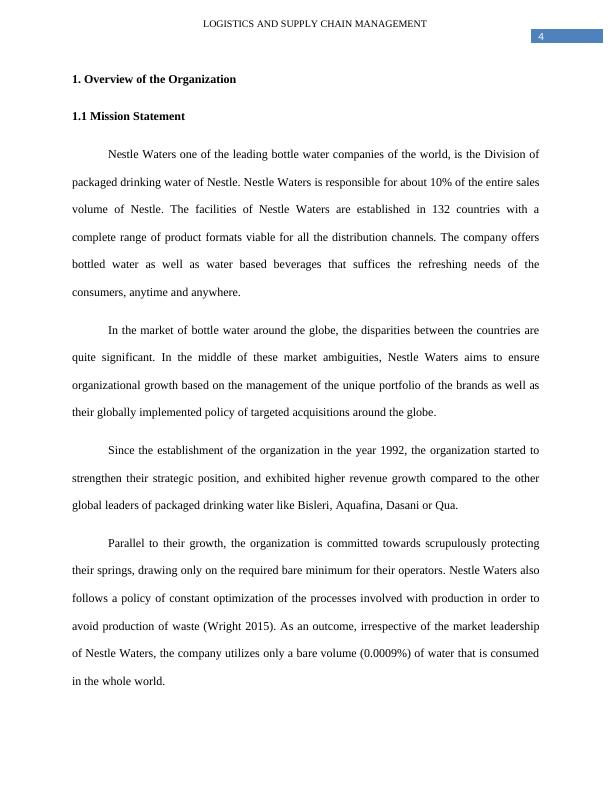
5
LOGISTICS AND SUPPLY CHAIN MANAGEMENT
This process helps the organization to maintain a sustainable business model and thereby
ensure that their customers get the best quality of finished products which can be counted as a
parameter for quality as well as purity (Smith 2017).
2. Discussion
2.1 SCOR Model of Supply Chain Management for Nestle Waters
2.1.1 Planning phase of supply chain management
The operations of Nestle Waters and their product lines are spread throughout the world.
However, in this report, emphasis will be given on the supply chain analysis of the packaged
drinking water business of the company. The supply chain management system of the brand is
unique. They export their packaged water mixing ingredients to the various bottling agents who
had agency of Nestle Waters in various parts of the world. In some of the European and
American locations, the company has directly owned bottling plants, like in Italy, Switzerland
and some areas of North America. Other exclusive territorial contractors of the company produce
the finished products in pouches as well as bottles (Nestle-waters.com, 2019). The filtered water
is mixed with the formulated mineral water mix of the company. On some instances sweetening
agents are mixed also. The bottling agencies around the globe then sells, distributes as well as
merchandises the resulting products of Nestle Waters to the retail outlets, food service agencies,
departmental and convenient stores and the vending machines within around 1300 kilometers
area from the bottling plants.
The Nestle Waters Supply Chain is segregated in to various levels. For the case of the
mineral water division of the company, the downstream activities of the organization are mostly
LOGISTICS AND SUPPLY CHAIN MANAGEMENT
This process helps the organization to maintain a sustainable business model and thereby
ensure that their customers get the best quality of finished products which can be counted as a
parameter for quality as well as purity (Smith 2017).
2. Discussion
2.1 SCOR Model of Supply Chain Management for Nestle Waters
2.1.1 Planning phase of supply chain management
The operations of Nestle Waters and their product lines are spread throughout the world.
However, in this report, emphasis will be given on the supply chain analysis of the packaged
drinking water business of the company. The supply chain management system of the brand is
unique. They export their packaged water mixing ingredients to the various bottling agents who
had agency of Nestle Waters in various parts of the world. In some of the European and
American locations, the company has directly owned bottling plants, like in Italy, Switzerland
and some areas of North America. Other exclusive territorial contractors of the company produce
the finished products in pouches as well as bottles (Nestle-waters.com, 2019). The filtered water
is mixed with the formulated mineral water mix of the company. On some instances sweetening
agents are mixed also. The bottling agencies around the globe then sells, distributes as well as
merchandises the resulting products of Nestle Waters to the retail outlets, food service agencies,
departmental and convenient stores and the vending machines within around 1300 kilometers
area from the bottling plants.
The Nestle Waters Supply Chain is segregated in to various levels. For the case of the
mineral water division of the company, the downstream activities of the organization are mostly
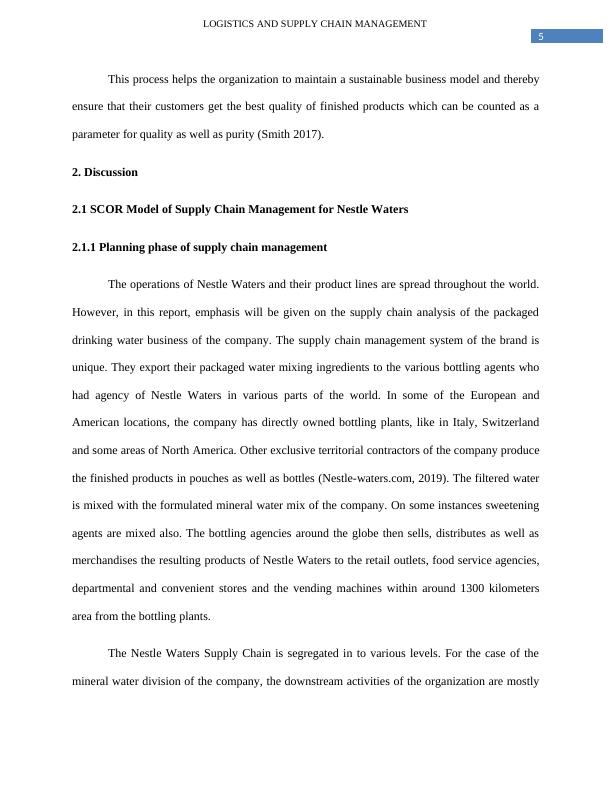
6
LOGISTICS AND SUPPLY CHAIN MANAGEMENT
required. These activities involve entailment of partnership with the various bottlers, distributers
as well as channels that are utilized for reaching the different retailers.
2.1.2 Sourcing
2.1.2.1 Downstream and Upstream Activities
The upstream activities of the company are limited to manufacturing of mineral water
mix formula. This contains the flavoring agents that help to keep the freshness of the taste and
color of the water intact. This formula is one of the most tightly held trade secrets of the
organization. Hence, there is very less information regarding the particular ingredients used. The
information regarding the cost of the supplies that goes in to manufacture of the ingredients are
also unknown, because of that. The organization holds the original copy of that formula in the
headquarters at Switzerland. The income statement of the company in the year 2018 holds that
the cost of goods for Nestle Waters had been excess of $10 million. The operating margin of the
organization had been around 25% (Nestle-waters.com, 2019). The largest known ingredient of
the organization had been added minerals as well as selected salts. There are various systems
employed by the company for the tracking of the daily variations of the global price of the
ingredients. Along with the specific mineral and salt that are there in the secret formula of the
company, other main ingredients which re used in the manufacturing of the finished processed
products are hydrogen carbonate, sodium, potassium, chloride, magnesium as well as sulfate.
The organization has various established supplier partnerships in order to procure these materials
and these partnerships are not under consideration in this project.
The maximum amount of water of Nestle Waters is sourced from the spring sources as
well as underground aquifers and not from the lakes, streams as well as reservoirs which supply
LOGISTICS AND SUPPLY CHAIN MANAGEMENT
required. These activities involve entailment of partnership with the various bottlers, distributers
as well as channels that are utilized for reaching the different retailers.
2.1.2 Sourcing
2.1.2.1 Downstream and Upstream Activities
The upstream activities of the company are limited to manufacturing of mineral water
mix formula. This contains the flavoring agents that help to keep the freshness of the taste and
color of the water intact. This formula is one of the most tightly held trade secrets of the
organization. Hence, there is very less information regarding the particular ingredients used. The
information regarding the cost of the supplies that goes in to manufacture of the ingredients are
also unknown, because of that. The organization holds the original copy of that formula in the
headquarters at Switzerland. The income statement of the company in the year 2018 holds that
the cost of goods for Nestle Waters had been excess of $10 million. The operating margin of the
organization had been around 25% (Nestle-waters.com, 2019). The largest known ingredient of
the organization had been added minerals as well as selected salts. There are various systems
employed by the company for the tracking of the daily variations of the global price of the
ingredients. Along with the specific mineral and salt that are there in the secret formula of the
company, other main ingredients which re used in the manufacturing of the finished processed
products are hydrogen carbonate, sodium, potassium, chloride, magnesium as well as sulfate.
The organization has various established supplier partnerships in order to procure these materials
and these partnerships are not under consideration in this project.
The maximum amount of water of Nestle Waters is sourced from the spring sources as
well as underground aquifers and not from the lakes, streams as well as reservoirs which supply
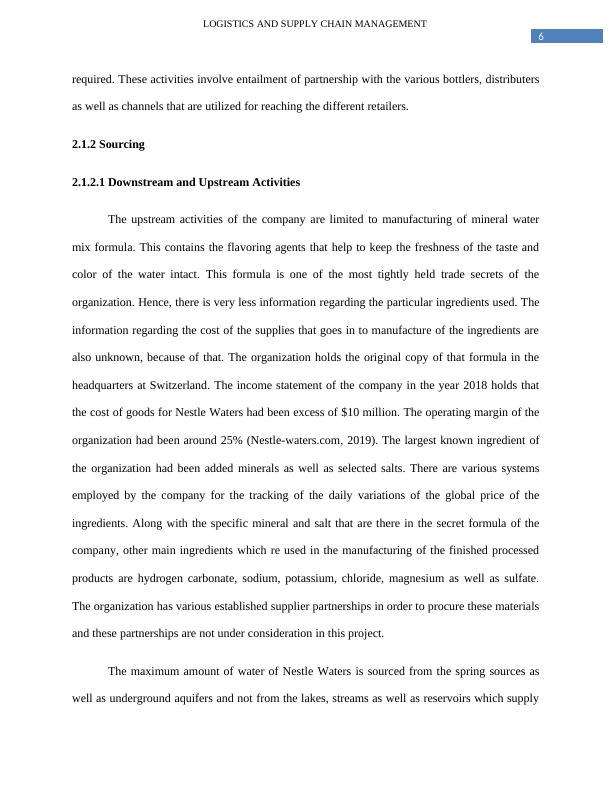
End of preview
Want to access all the pages? Upload your documents or become a member.
Related Documents
Inventory and Distribution Management - Nestlelg...
|20
|4793
|347
Nestle - Supply Chain & Strategylg...
|35
|11764
|119
Logistics and Supply Chain Management of Nestlelg...
|13
|2875
|471
Importance of Packaging for Marketing of Drinking Water - Research Proposallg...
|5
|1290
|267
Operation and Project Managementlg...
|27
|6368
|84
Strategic Management: Analysis of Nestle's Success and Strategieslg...
|14
|4288
|363
